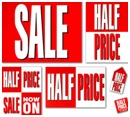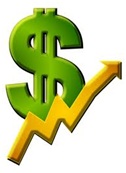|
 |
|
 |
Pricing
Pricing is... Deciding what price to charge for a product.
What to consider to get the price right
1. Customer benefits The price customers will pay for a product will depend on the benefits (actual and perceived) they get from it e.g. quality, image, style, convenience, etc. They must think that it is a fair price. These pricing methods are used to make a product appear more beneficial and attractive:
a) psychological pricing Price changes affecting customer perceptions (e.g. £1.99 instead of £2) and high prices for high quality and exclusivity like designer clothes (also called premium pricing).
b) loss leaders Products sold at a loss to attract customers to other products (often used in supermarkets).
c) variable pricing (or price discrimination) - charging different prices to different customers for the same product e.g. night time electricity.
d) discount pricing – lower prices for a limited time.
2. Market forces and competition The market price is determined by supply (from producers) and
demand (from customers):
The economist’s concept of price elasticity of demand measures the impact of price changes on demand. A product may have elastic or inelastic demand:
a) elastic demand i.e. a percentage decrease in price leads to a higher percentage increase in demand (making a price reduction more profitable). This happens when there are lots of competitors selling similar products. A company is also more likely to reduce prices, if it can benefit from economies of scale (cost reductions from mass production). Penetration pricing sets low prices to gain high sales and is normally used for fast moving consumable goods (fmcg’s) e.g. cola.
b) inelastic demand i.e. a percentage increase in price leads to a lower percentage decrease in demand (making a price increase more profitable). This happens when customers are prepared to pay a higher price (or premium price) for products that are better than competitors (i.e. there is product differentiation). For example, a “skimming” strategy charges a high price to richer customers (usually used for revolutionary new products).
3. Costs Price must pay for a product’s costs (fixed and variable – see costing) and provide a profit. So cost-plus pricing calculates price as follows: Costs per product (unit costs) + profit (called the mark-up or profit margin). But there are problems with this:
Contribution pricing chooses a price that maximizes a product’s contribution i.e. sales revenue (price x products sold) less total variable costs.
4. Capital employed In analysing accounts, we saw that every business has capital employed (or the amount of money invested in it), and an important measure of its profitability is return on capital employed: Net profit x 100% Capital employed Target return pricing sets a price to achieve a certain return on capital employed. For example: Target return – 10% Products sold – 2,000 Capital employed - $100,000 Total costs - $10,000 A price of $10 leads to a net profit of $10,000 ($20,000 revenue less $10,000 costs) This profit leads to a return on capital employed of 10% (the target return) - (10,000 ÷ 100,000) x 100%.
Key quotes explained
“Never knowingly undersold” - John Spedan Lewis, founder of the British department store chain, the John Lewis Partnership, which became its marketing slogan. John Lewis has this policy of matching another store’s price for the same product, however low it might be.
“Pleasing ware is half sold” - George Herbert ,English poet (pictured right) This is just as true today as when he wrote this in 1651! A pleasing product is at least as important as its price. Even a cheap price is wasted, if the product is no good. “Poor lawyers, like poor paintings, are dear at any price”, said the American artist, James Whistler.
“The real price of everything...is the toil and trouble of acquiring it” - Adam Smith (Scottish philosopher and economist, pictured right) People spend their hard earned cash buying something, so value for money is vital.
Best books
Alfred Marshall (pictured right), Principles of Economics (1890) Professor Marshall was the first person to show that price is determined by supply and demand, coining the term, price elasticity of demand. |
|
|
||
|
|
|
||
|
||
| Copyright © wisdomtowin.com All Rights Reserved | ||
|











